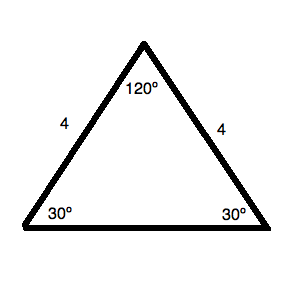

Likely the most commonly known equation for calculating the area of a triangle involves its base, b, and height, h. There are multiple different equations for calculating the area of a triangle, dependent on what information is known. Refer to the triangle above, assuming that a, b, and c are known values. Given the lengths of all three sides of any triangle, each angle can be calculated using the following equation.Note that there exist cases when a triangle meets certain conditions, where two different triangle configurations are possible given the same set of data. Thus, if b, B and C are known, it is possible to find c by relating b/sin(B) and c/sin(C). Where sides a, b, c, and angles A, B, C are as depicted in the above calculator, the law of sines can be written as shown below. Using the law of sines makes it possible to find unknown angles and sides of a triangle given enough information. Law of sines: the ratio of the length of a side of a triangle to the sine of its opposite angle is constant.Where a and b are two sides of a triangle, and c is the hypotenuse, the Pythagorean theorem can be written as: There are also special cases of right triangles, such as the 30° 60° 90, 45° 45° 90°, and 3 4 5 right triangles that facilitate calculations. It follows that any triangle in which the sides satisfy this condition is a right triangle. For any right triangle, the square of the length of the hypotenuse equals the sum of the squares of the lengths of the two other sides. Pythagorean theorem: The Pythagorean theorem is a theorem specific to right triangles.The sum of the lengths of any two sides of a triangle is always larger than the length of the third side.Another way to calculate the exterior angle of a triangle is to subtract the angle of the vertex of interest from 180°. The interior angles of a triangle always add up to 180° while the exterior angles of a triangle are equal to the sum of the two interior angles that are not adjacent to it.It is not possible for a triangle to have more than one vertex with internal angle greater than or equal to 90°, or it would no longer be a triangle.In an obtuse triangle, one of the angles of the triangle is greater than 90°, while in an acute triangle, all of the angles are less than 90°, as shown below. Any triangle that is not a right triangle is classified as an oblique triangle and can either be obtuse or acute. The longest edge of a right triangle, which is the edge opposite the right angle, is called the hypotenuse. A right triangle is a triangle in which one of the angles is 90°, and is denoted by two line segments forming a square at the vertex constituting the right angle. Triangles classified based on their internal angles fall into two categories: right or oblique. When actual values are entered, the calculator output will reflect what the shape of the input triangle should look like. Note that the triangle provided in the calculator is not shown to scale while it looks equilateral (and has angle markings that typically would be read as equal), it is not necessarily equilateral and is simply a representation of a triangle.

As can be seen from the triangles above, the length and internal angles of a triangle are directly related, so it makes sense that an equilateral triangle has three equal internal angles, and three equal length sides. Similar notation exists for the internal angles of a triangle, denoted by differing numbers of concentric arcs located at the triangle's vertices. Tick marks on the edge of a triangle are a common notation that reflects the length of the side, where the same number of ticks means equal length. When none of the sides of a triangle have equal lengths, it is referred to as scalene, as depicted below. For example, a triangle in which all three sides have equal lengths is called an equilateral triangle while a triangle in which two sides have equal lengths is called isosceles. Furthermore, triangles tend to be described based on the length of their sides, as well as their internal angles. Hence, a triangle with vertices a, b, and c is typically denoted as Δabc. A triangle is usually referred to by its vertices. A vertex is a point where two or more curves, lines, or edges meet in the case of a triangle, the three vertices are joined by three line segments called edges. When radians are selected as the angle unit, it can take values such as pi/2, pi/4, etc.Ī triangle is a polygon that has three vertices. Please provide 3 values including at least one side to the following 6 fields, and click the "Calculate" button.

Home / math / triangle calculator Triangle Calculator


 0 kommentar(er)
0 kommentar(er)
